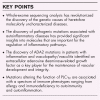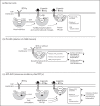When less is more: primary immunodeficiency with an autoinflammatory kick
- PMID: 25337682
- PMCID: PMC4212813
- DOI: 10.1097/ACI.0000000000000117
When less is more: primary immunodeficiency with an autoinflammatory kick
Abstract
Purpose of review: Next-generation sequencing is revolutionizing the molecular taxonomy of human disease. Recent studies of patients with unexplained autoinflammatory disorders reveal germline genetic mutations that target important regulators of innate immunity.
Recent findings: Whole-exome analyses of previously undiagnosed patients have catalyzed the recognition of two new disease genes. First, a phenotypic spectrum, including livedo racemosa, fever with early-onset stroke, polyarteritis nodosa, and Sneddon syndrome, is caused by loss-of-function mutations in cat eye syndrome chromosome region, candidate 1 (CECR1), encoding adenosine deaminase 2. Adenosine deaminase 2 is a secreted protein expressed primarily in myeloid cells, and a regulator of macrophage differentiation and endothelial development. Disease-associated mutations impair anti-inflammatory M2 macrophage differentiation. Second, patients presenting with cold-induced urticaria, granulomatous rash, autoantibodies, and common variable immunodeficiency, or with blistering skin lesions, bronchiolitis, enterocolitis, ocular inflammation, and mild immunodeficiency harbor distinct mutations in phospholipase Cγ₂, encoding a signaling molecule expressed in natural killer cells, mast cells, and B lymphocytes. These mutations inhibit the function of a phospholipase Cγ₂ autoinhibitory domain, causing increased or constitutive signaling.
Summary: These findings underscore the power of next-generation sequencing, demonstrating how the primary deficiency of key molecular regulators or even regulatory motifs may lead to autoinflammation, and suggesting a possible role for cat eye syndrome chromosome region, candidate 1 and phospholipase Cγ₂ in common diseases.
Figures



Similar articles
-
Monogenic polyarteritis: the lesson of ADA2 deficiency.Pediatr Rheumatol Online J. 2016 Sep 8;14(1):51. doi: 10.1186/s12969-016-0111-7. Pediatr Rheumatol Online J. 2016. PMID: 27609179 Free PMC article. Review.
-
Deficiency of Adenosine Deaminase 2 (DADA2), an Inherited Cause of Polyarteritis Nodosa and a Mimic of Other Systemic Rheumatologic Disorders.Curr Rheumatol Rep. 2017 Oct 5;19(11):70. doi: 10.1007/s11926-017-0699-8. Curr Rheumatol Rep. 2017. PMID: 28983775 Review.
-
Early-onset stroke and vasculopathy associated with mutations in ADA2.N Engl J Med. 2014 Mar 6;370(10):911-20. doi: 10.1056/NEJMoa1307361. Epub 2014 Feb 19. N Engl J Med. 2014. PMID: 24552284 Free PMC article.
-
Cold urticaria, immunodeficiency, and autoimmunity related to PLCG2 deletions.N Engl J Med. 2012 Jan 26;366(4):330-8. doi: 10.1056/NEJMoa1102140. Epub 2012 Jan 11. N Engl J Med. 2012. PMID: 22236196 Free PMC article.
-
Expanding spectrum of DADA2: a review of phenotypes, genetics, pathogenesis and treatment.Clin Rheumatol. 2021 Oct;40(10):3883-3896. doi: 10.1007/s10067-021-05711-w. Epub 2021 Mar 31. Clin Rheumatol. 2021. PMID: 33791889 Review.
Cited by
-
Variant in the PLCG2 Gene May Cause a Phenotypic Overlap of APLAID/PLAID: Case Series and Literature Review.J Clin Med. 2022 Jul 27;11(15):4369. doi: 10.3390/jcm11154369. J Clin Med. 2022. PMID: 35955991 Free PMC article.
-
Immune Monitoring of Patients With Primary Immune Regulation Disorders Unravels Higher Frequencies of Follicular T Cells With Different Profiles That Associate With Alterations in B Cell Subsets.Front Immunol. 2020 Oct 29;11:576724. doi: 10.3389/fimmu.2020.576724. eCollection 2020. Front Immunol. 2020. PMID: 33193371 Free PMC article.
-
Characterization of total adenosine deaminase activity (ADA) and its isoenzymes in saliva and serum in health and inflammatory conditions in four different species: an analytical and clinical validation pilot study.BMC Vet Res. 2020 Oct 12;16(1):384. doi: 10.1186/s12917-020-02574-2. BMC Vet Res. 2020. PMID: 33046093 Free PMC article.
-
Bar Code Reader - an algorithmic approach to cutaneous occluding vasculopathies? part II medium vessel vasculopathies.J Dtsch Dermatol Ges. 2019 Nov;17(11):1115-1128. doi: 10.1111/ddg.13973. J Dtsch Dermatol Ges. 2019. PMID: 31765098 Free PMC article. Review.
-
Functional characterization of phospholipase C-γ2 mutant protein causing both somatic ibrutinib resistance and a germline monogenic autoinflammatory disorder.Oncotarget. 2018 Sep 28;9(76):34357-34378. doi: 10.18632/oncotarget.26173. eCollection 2018 Sep 28. Oncotarget. 2018. PMID: 30344948 Free PMC article.
References
-
- International FMF Consortium. Ancient missense mutations in a new member of the RoRet gene family are likely to cause familial Mediterranean fever. Cell 1997; 90:797–807 - PubMed
-
- French FMF Consortium. A candidate gene for familial Mediterranean fever. Nat Genet 1997; 17:25–31 - PubMed
-
- McDermott MF, Aksentijevich I, Galon J, et al. Germline mutations in the extracellular domains of the 55 kDa TNF receptor, TNFR1, define a family of dominantly inherited autoinflammatory syndromes. Cell 1999; 97:133–144 - PubMed
Publication types
MeSH terms
Substances
Grants and funding
LinkOut - more resources
Full Text Sources
Other Literature Sources
Medical
Research Materials
Miscellaneous

